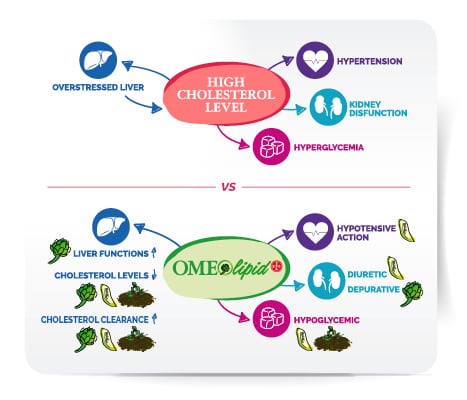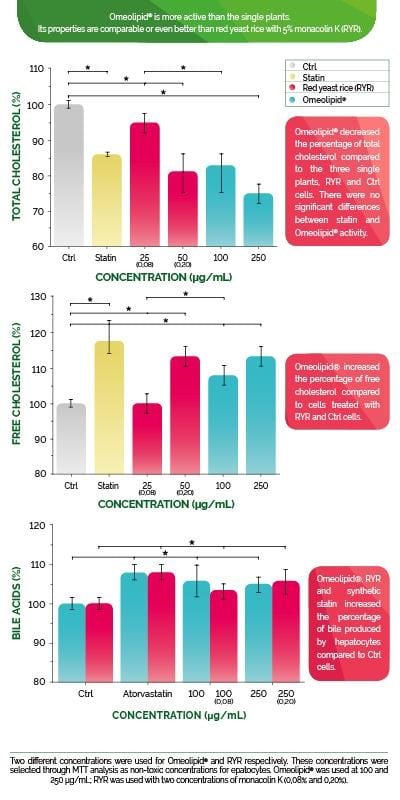Cholesterol is a fatty substance known as a lipid and is vital for the normal functioning of the body.
While it can be found in some foods, it is mainly produced in the liver. Hence, the liver is the most important organ involved in lipid metabolism. Since it has a vital function, it is essential to preserve and improve liver health, and its functions.
Cholesterol is carried in your blood by lipoproteins, which exist in two main types:
- high-density lipoprotein (HDL). HDL is referred to as “good cholesterol” as this protein carries cholesterol away from the cells and back to the liver, where it is either broken down or passed out of the body as a waste product;
- low-density lipoprotein (LDL), known as “bad cholesterol”. LDL carries cholesterol to the cells that need it, but if there's too much cholesterol for the cells to use, it can build up in the artery walls, leading to disease of the arteries and – accordingly – to overstressed liver and an increased oxidative stress. Moreover, evidence strongly indicates that high cholesterol can increase the risk of narrowing of the arteries (atherosclerosis) and coronary heart diseases.
While most natural and synthetic ingredients already on the market only decrease cholesterol levels, Omeolipid by EPO acts differently, offering a more complete and holistic approach to lipid balance and wellbeing.

Figure 1 The holistic approach promoted by Omeolipid
Omeolipid is the synergic combination of three plants: artichoke, caihua and fenugreek , which make it unique compared to other ingredients.
It has anticholesterolemic, hypolipidemic and cholagogue properties, standardized to contain ≥ 3 % chlorogenic acid.
Artichoke (Cynara scolymus L) is a Mediterranean plant; its cultivation in Europe dates to ancient Greece and Rome. Its active substances (caffeoylquinic acids, flavonoids, sesquiterpene lactones) are concentrated in the leaf, acting as digestive, cholagogue, hepatoprotective and depurative.
Caihua (Cyclanthera pedata (L.) Schrad.) is a traditional plant from South America; the fruit contains flavonoids and in Peru its use is documented since 3700 b.C. as hypotensive, antidiabetic, anti-inflammatory and hypocholesterolemic.
Fenugreek (Trigonella foenum-graecum L.) is a milestone of the Ayurvedic medicine, alleviating kapha and vata. The seeds contain saponins, coumarins, flavonoids and alkaloids. They have hypocholesterolemic, diuretic, diaphoretic, carminative, hypoglycemic, demulcent properties and they are traditionally used to treat obesity and diabetes.
Action
Omeolipid promotes strong hepatoprotective and antioxidant effects, as well as depurative effect (artichoke and caihua). It also promotes bile production and flow, essential for cholesterol clearance; fenugreek decreases gut absorption of cholesterol and therefore its uptake.
Omeolipid is also able to counteract adverse effects commonly associated with obesity and high levels of cholesterol:
- altered carbohydrate metabolism: caihua and fenugreek improve glycemic level control, as they are hypoglycemic agents;
- kidney dysfunction (caihua improves diuresis);
- hypertension (caihua helps regulating blood pressure).

Figure 2 anti-cholesterolemic and cholagogue activity of Omeolipid
The anticholesterolemic and cholagogue activities of Omeolipid were evaluated on human in vitro liver model (HEPG2 cell line). Total cholesterol is made of two fractions: esterified for cholesterol transport in blood (HDL, LDL) and free or non-esterified for its elimination via bile.
The synergic combination of the three plants is what makes Omeolipid a unique product, more active than the single plants. Its properties are comparable or even better than red yeast rice with 5% monacolin K (RYR). The product of yeast (Monascus purpureus) grown on white rice, red yeast rice extract (RYRE) is a traditional Chinese medicine commonly known for being one of the top natural remedies for high cholesterol levels.

Figure 3 Omeolipid properties are comparable or even better than red yeast rice with 5% monacolin K (RYR)
Conclusion
Omeolipid is the synergic combination of three plants: a rtichoke, caihua and Fenugreek , which make it unique compared to other ingredients.
It has anticholesterolemic , hypolipidemic and cholagogue properties, standardized to contain ≥ 3 % chlorogenic acid.
Due to its outstanding features, Omeolipid can be used in food supplements for its anti cholesterolemic and cholagogue properties.
Omeolipid by EPO srl is distributed within the North American market by Faravelli, Inc, the US branch of Faravelli, an Italian company and global distributor of ingredients and raw materials, founded in 1926.
References
1. Capasso F, Grandolini G, Izzo AA. Fitoterapia. Impiego razionale delle droghe vegetali. Springer-Verlag editor. Third edition 2006
2. Liu J, Zhang J, Shi Y, Grimsgaard S, Alraek T, Fonnebo V. Chinese red yeast rice (Monascus purpureus) for primary hyperlipidemia: a meta-analysis of randomized controlled trials. Chinese Medicine 2006. 1:4
3. Ecam Ricert. Evaluation of anti-cholesterolemic activity of three extracts. Report April 2018. N.18-3518
4. Brack Egg A. Perù: diez mil años de domesticación. Bruno editor 2003
5. Pole S. Ayurvedic medicine. The principles of traditional practice. Elsevier editor 2006 technical datasheet is available at www.eposrl.com





